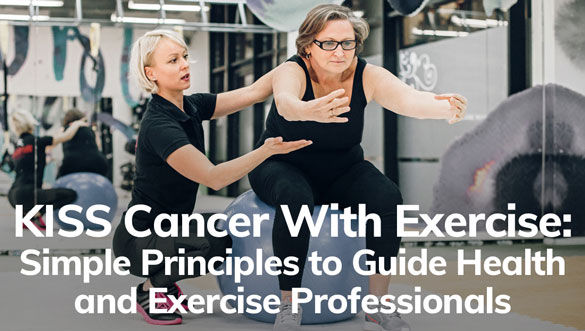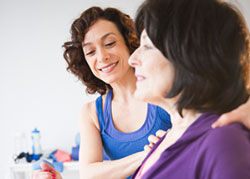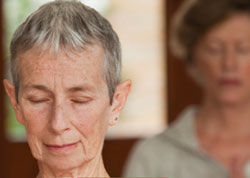
What happens when the lines between health, wellness and fitness become blurred and your client who is in the best shape of his or her adult life is suddenly diagnosed with cancer? What implications does this have for your work with the client, how do you communicate with him or her, and what might you expect as your client straddles the line between sickness and wellness?
According to the American Cancer Society (ACS), nearly 40% of Americans will be diagnosed with cancer during their lifetime. In 2018 alone, 1.7 million Americans received a diagnosis, which suggests that nearly everyone reading this article will undoubtedly be affected by cancer in one way or another. Although these are alarming statistics, the good news is that survival rates are also increasing. There are an estimated 15.5 million cancer survivors in the U.S. today, which is expected to double by 2040. While significant strides have been made in the areas of diagnosis and treatment, recognizing and treating emotional and long-term physical effects are often overlooked. As a health and exercise professional, you have an incredible opportunity to impact the lives of these individuals through exercise.
The first cancer-specific exercise guidelines were published in 2010 and stated that individuals with cancer should remain active and meet the general Physical Activity Guidelines for Americans. Based on compounding evidence, the cancer-specific guidelines were revised in 2019 and provided more specificity based on cancer type, treatment timepoints and specific intensities, frequencies and modalities (American College of Sports Medicine, 2019).

In case you missed it…
As a health and exercise professional, you are on the front lines for the cancer survivor population. This article covers basic recommendations for working with cancer survivors and the research supporting the benefits of exercise for prevention, pre-habilitation and treatment, and describes a framework for assessing clients and creating programs that address their individual needs.
Connection to the Health and Exercise Professional
It can be a challenge to know what to say or not to say to someone who is diagnosed with cancer. Even for someone with whom you have great rapport and history, you may feel uncertain as to how to communicate effectively and provide the same fitness-related support. In this article, we highlight three broad areas of the diagnostic and treatment process that will be key points in time for health and exercise professionals to provide both emotional and physical support.
Let’s start with a fairly common, yet unfortunate, scenario of how the conversation around just learning your client has cancer may go. In this scenario, the health and exercise professional and the client (Jane) have been training together for the past year, one to two times per week. Jane is generally consistent with her exercise program, but periodically takes a two- to three-week hiatus for work or life issues. Jane has just returned from a hiatus.
- Professional: Hey Jane! Great to have you back! How are you?
- Jane: Um, I’m O.K.. I just found out that the weird stomach pains I’ve had are colon cancer.
- Professional: (shocked look) Wow! Do you have a family history? Do you think that the fast food you’ve been eating while traveling might have something to do with your cancer?
- Jane: I don’t know. But I hope I didn’t cause this.
- Professional: Well, let me know what I can do, but I’m sure you will be fine! Ready to work out?
While pretending cancer is not a big deal (as portrayed in the example above) may not be the most appropriate approach, avoiding the issue altogether is actually a fairly common response. Jane doesn’t look sick, she is there to work out and who wants to pry?
Stories like this happen with regularity when people share their diagnoses with health and exercise professionals, work colleagues or others they see on a regular basis. Here is an example of how the conversation could go differently with the professional playing a much more supportive role.
- Professional: Hey Jane! Great to have you back! How are you?
- Jane: Um, I’m O.K. I just found out that the weird stomach pains I’ve had are colon cancer.
- Professional: Jane, I’m so sorry to hear that. I know you’ve been working hard to be healthy and strong. How are you feeling about this diagnosis?
- Jane: I’m not sure. I’ve only known people who have died from cancer so I’m feeling really anxious.
- Professional: While I don’t know the details about your cancer or the prognosis, I know a lot of others that have gone through cancer and you actually work out around them all of the time! They may not have the exact diagnosis you have, but I can introduce you if and when you are ready.
- Jane: Thanks. I’m just not sure what I want or need at the moment.
- Professional: I want you to know that I’m here to help and support you every step of the way from a fitness perspective. I recently read an article about how important exercise is for someone with a cancer diagnosis. I would be happy to find it and share it with you if you would like.
- Jane: Thanks, that would help a lot. Can you bring it to our next session?
- Professional: Absolutely. Keep in mind that we can modify anything just like we did when you were recovering from the flu. I know that’s not the same, but movement might actually help you feel better. Let’s just take it one workout at a time. How does that sound?
- Jane: Yes, that sounds great. Thank you so much for your support. Let’s get to the workout so I can feel like I’m doing something positive and healthy!
In this example, the health and exercise professional did not avoid the topic and kept the conversation simple and to the point. The health and exercise professional communicated that Jane was not alone, offered support and did not offer false hope. Ultimately, Jane decided when she was done with the conversation and ready to do her workout. This shows Jane that she will be heard and that her training sessions can continue even when she may be feeling overwhelmed or anxious or experiencing cancer symptoms or treatment side effects.
Other positive questions and statements include the following:
- Thank you for sharing something so personal with me. Is there anything that you can think of today that I can do to help you?
- I can’t imagine what you must be feeling or thinking right now. (Note: Unless you can, in which case you can state something emotionally around your own diagnosis; however, refrain from presuming your path is the same as your client’s.)
- Do you have specific goals about your fitness, wellness or nutrition today? (Be prepared to offer suggestions, as your client may have no idea how to respond. For example: Would you like to continue exercising in the gym or at home? Have you thought about talking to a registered dietitian to help you with nutrition? Because you are expected to have abdominal surgery in the future, what do you think about adding more core exercises to our workouts?)
- I’m not certain what to say but I’m here for you.
AVOID making statements such as:
- Everything happens for a reason.
- God only gives you what you can handle. You must be so strong.
- My neighbor had that cancer and she’s doing great (or she died).
- You’re so fit! You will be fine!
- You have to think positive.
- You should [insert just about anything here, such as you should really be happy that you don’t have to have radiation or chemo].
Lastly, as suggested above, avoid saying nothing or pretending a diagnosis isn’t a big deal. To most people, cancer is incredibly scary, and even when the prognosis is good, many still wonder if they will die. Here are a few tips for when your client is uncertain of what he or she needs or wants around this conversation.
- Offer to provide your client with the current cancer exercise recommendations in electronic or printed format.
- Build your knowledge. Find research about the client’s particular cancer and exercise recommendations and share the article or information you learn when you see your client again. Look up reputable organizations such as the American Cancer Society to learn more about cancer and treatment approaches. For exercise-related research, Google Scholar and PubMed are great sources of information, as are the websites of reputable cancer centers.
- Offer to be a contact for your client’s clinical healthcare team if they have any questions or need to provide recommendations.
While exercise is important and very beneficial throughout treatment and survivorship, the following specific tips that will be helpful at key points in time to best direct your client.
A New Diagnosis
A newly diagnosed individual is often experiencing a variety of emotions and thoughts simultaneously, such as shock, disbelief, fear, sadness, confusion and anger. Taking time to fully process these thoughts and feelings is also difficult, as medical professionals tend to move quickly from diagnosis to treatment. Cancer takes a lot away from people and many are scared that they will not be able to exercise. As a health and exercise professional, you may also experience many of the same feelings; however, your job is to provide assuring support and a positive attitude while offering your client support throughout the process.
Treatment usually includes a combination of therapies such as surgery, chemotherapy and radiation. Although there will likely be adjustments and modifications to their normal exercise routines, your clients should be encouraged to continue to exercise as tolerated. Exercise has positive benefits for patients during treatments in many areas of health-related quality of life. For example, exercise has been shown to improve mood (depression), fatigue, sleep and emotional well-being through numerous clinical studies examining the effects of various exercise modalities and intensities. A review of 56 clinical trials with 4,826 participants randomized to an exercise intervention found improvement in all of the areas identified above. It is important to note that these results were not the same across the board for all types of cancer patients (just as all of your clients are not all the same). For example, exercise was found to elicit a greater reduction in anxiety levels for breast cancer survivors versus other types of cancer. And, moderate or vigorous levels of intensity have greater positive effects than light-intensity exercise programs (Mishra et al., 2012).
Take a look at this exchange with a newly diagnosed client after he or she has informed the health and exercise professional of a cancer diagnosis.
- Professional: I really encourage you to keep exercising throughout the treatment process. While we may need to make some adjustments depending on how you feel, exercise will help you maintain your strength and energy.
- Jane: Yes, I know. I’m just worried that I won’t be able to keep up with what I used to do or that I’m going to feel too tired.
- Professional: Let’s take it one session at a time. Some days you may feel stronger than others, so why don’t we come up with a general plan and we will adjust each session depending on your energy level?
- Jane: Thanks. I really like that plan. I just don’t know what to expect.
- Professional: While we don’t have all the answers today, I’m confident that, with the knowledge of your medical team and my knowledge of exercise science*, and the amount of research on the positive effects of exercise during treatment, we will figure this out.
*Note: As a health and exercise professional, it’s impossible to keep up with all of the individual research studies, but it’s important to be confident in focusing on the big picture with your client.
During Treatment
For an individual currently in treatment or for someone living with advanced cancer who will likely continue to receive treatment in the future, it’s important to understand that the effects of those treatments are cumulative. Two key indicators that inform how much the treatments are impacting an individual are related to his or her blood counts and immune system. A primary concern for people being treated for cancer is that they are often at a higher risk for infections due to the impact of having a low white blood cell count.
Be aware that it is common for oncology teams to discourage going to the gym (and other crowded areas) while someone is having chemotherapy. However, newer medications given in conjunction with chemotherapy can improve white blood cell counts and help maintain a stronger immune system. For your clients, exercising during treatment not only reduces their fatigue during this phase, but also reduces many of the long-term and late effects that they may experience many years down the road (May et al., 2018).
When working with clients in treatment, it is important to be extra diligent about good hand washing and sanitizing, keeping equipment clean and working in less-crowded areas of the gym. Encourage clients to use their own towels or wear workout gloves and to wash them on a regular basis.
Here are some specific questions to ask your clients during the treatment phase to better understand how they are feeling on any given day and to make certain you can provide the best possible workouts for them.
Rather than start with a general question such as, “How are you?” be specific. Ask questions such as:
- How is your energy today? (Use a rating system such as a 1−5 scale or terms such as moderate, good and great.)
- Is there anything specific you would like to work on today or, conversely, is there anything you’d rather not do based on how you feel?
- Do you have any new or different side effects I should know about, such as dizziness, neuropathy, pain, nausea, etc.?
Post-treatment
For the majority of individuals, the goal is to complete treatment and reach survivorship. Although the end of treatment is generally cause for celebration, it is often accompanied with mixed emotions and ongoing emotional adjustments to physical changes such as surgery scars, weight fluctuations and long-term neuropathy, just to name a few. While this is generally a positive time for many people, it can also be an emotional roller coaster of anxiety, fear, uncertainty and frustrations. At this point, the patient is given a survivorship care plan and passed back to his or her primary care physician.
Throughout this process, your clients are often left to figure out their “new normal” on their own, when, in reality, they’d simply prefer to go back to the lives they had before cancer. For health and exercise professionals, supportive and direct communication during this time is always the way to go. Consider the following exchange:
- Professional: Hey, Jane! I am so happy for you that you have completed your treatments. How do you feel about being “done”?
- Jane: I’m so glad to be done with all of those appointments! My entire life seemed to revolve around cancer. I’m a bit nervous about all of the things that I’m supposed to watch for that might indicate a recurrence. Now I feel like every ache and pain is cancer coming back.
- Professional: I think those fears are normal and to be expected. Before you were diagnosed, I’m sure you didn’t even think twice about your back or hips hurting. But now that you’re more aware of what pains can mean, I know it’s much different. One of the best things about continuing to exercise is that you stayed in tune with your body. We will continue to keep a close eye on when something doesn’t feel right or if there is a new pain.
- Jane: Yes, that’s true. I know the difference between workout pain and unexplained pain. I just need to remind myself that not every pain is bad.
- Professional: That sounds like a good strategy. So, let’s work together to communicate about things that may feel differently to understand if they are related to your workouts. With the surgeries on your abdomen, we need to keep working on core strength and stability. This may make the muscles of your lower back or hips feel sore. Let me know how you are feeling so we can make sure to adjust the workouts as needed as you regain strength.
- Jane: Thanks! Yes, that sounds great! I want to feel strong again!
While it’s easy to get excited for your client, try to avoid making things a big celebration unless that is what he or she wants. Avoid making statements such as, “Now that you are done, we can just get back to what we used to do” or “Wow, you look great,” which may make the client wonder if he or she looked bad during treatment. Feel free to complement your client’s hair growth, especially when he or she removes the scarves, hats and/or wigs after feeling more confident due to hair growth.
As the clinical evidence on the impact of exercise on the side effects and symptom management of cancer continues to grow, implementing the learnings from this research with the individuals who need this guidance the most is a key piece of helping those living with and beyond their diagnoses. Cancer survivors are seeking the support and encouragement of health and exercise professionals, which means your role is crucial to increasing the number of cancer survivors living well after their diagnosis.
References
American College of Sports Medicine (2019). Exercise guidelines for cancer survivors. Medicine & Science in Sports & Exercise, 51, 11, 2375−2390.
Cancer Statistics. (2018). Cancer statistics. National Cancer Institute.
May, A. et al. (2018) Four-year effects of physical exercise during adjuvant treatment on fatigue and physical activity in breast and colon cancer patients. BMC Medicine, 16, 1, 86.
Mishra, S.I. et al. (2012). Exercise interventions on health-related quality of life for people with cancer during active treatment. Cochrane Database of Systematic Reviews, 8, CD008465.





 by
by 






